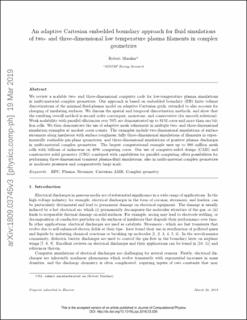| dc.contributor.author | Marskar, Robert | |
| dc.date.accessioned | 2020-08-11T12:47:22Z | |
| dc.date.available | 2020-08-11T12:47:22Z | |
| dc.date.created | 2019-04-24T08:57:48Z | |
| dc.date.issued | 2019 | |
| dc.identifier.citation | Journal of Computational Physics. 2019, 388 624-654. | en_US |
| dc.identifier.issn | 0021-9991 | |
| dc.identifier.uri | https://hdl.handle.net/11250/2671505 | |
| dc.description.abstract | We review a scalable two- and three-dimensional computer code for low-temperature plasma simulations in multi-material complex geometries. Our approach is based on embedded boundary (EB) finite volume discretizations of the minimal fluid-plasma model on adaptive Cartesian grids, extended to also account for charging of insulating surfaces. We discuss the spatial and temporal discretization methods, and show that the resulting overall method is second order convergent, monotone, and conservative (for smooth solutions). Weak scalability with parallel efficiencies over 70% are demonstrated up to 8192 cores and more than one billion cells. We then demonstrate the use of adaptive mesh refinement in multiple two- and three-dimensional simulation examples at modest cores counts. The examples include two-dimensional simulations of surface streamers along insulators with surface roughness; fully three-dimensional simulations of filaments in experimentally realizable pin-plane geometries, and three-dimensional simulations of positive plasma discharges in multi-material complex geometries. The largest computational example uses up to 800 million mesh cells with billions of unknowns on 4096 computing cores. Our use of computer-aided design (CAD) and constructive solid geometry (CSG) combined with capabilities for parallel computing offers possibilities for performing three-dimensional transient plasma-fluid simulations, also in multi-material complex geometries at moderate pressures and comparatively large scale. | en_US |
| dc.description.abstract | An adaptive Cartesian embedded boundary approach for fluid simulations of two- and three-dimensional low temperature plasma filaments in complex geometries | en_US |
| dc.language.iso | eng | en_US |
| dc.publisher | Elsevier | en_US |
| dc.rights | Attribution-NonCommercial-NoDerivatives 4.0 Internasjonal | * |
| dc.rights.uri | http://creativecommons.org/licenses/by-nc-nd/4.0/deed.no | * |
| dc.title | An adaptive Cartesian embedded boundary approach for fluid simulations of two- and three-dimensional low temperature plasma filaments in complex geometries | en_US |
| dc.type | Peer reviewed | en_US |
| dc.type | Journal article | en_US |
| dc.description.version | acceptedVersion | en_US |
| dc.source.pagenumber | 624-654 | en_US |
| dc.source.volume | 388 | en_US |
| dc.source.journal | Journal of Computational Physics | en_US |
| dc.identifier.doi | 10.1016/j.jcp.2019.03.036 | |
| dc.identifier.cristin | 1693582 | |
| dc.relation.project | Norges forskningsråd: 245422 | en_US |
| dc.relation.project | Nortur/NorStore: NN9453K | en_US |
| cristin.unitcode | 7548,30,0,0 | |
| cristin.unitname | Elkraftteknologi | |
| cristin.ispublished | true | |
| cristin.fulltext | postprint | |
| cristin.qualitycode | 1 | |

